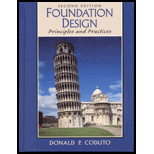Sorry! We don’t have solutions for this edition yet.
Solutions are available for other editions of this book
View 3rd Edition solutionsarrow_forwardBook Details
For undergraduate/graduate-level foundation engineering courses.
Covers the subject matter thoroughly and systematically, while being easy to read. Emphasizes a thorough understanding of concepts and terms before proceeding with analysis and design, and carefully integrates the principles of foundation engineering with their application to practical design problems.
Features
- NEW--Expanded coverage of earth retaining structures--Features separate full chapters on cantilever walls and sheet pile walls.
- Teaches students how to design both kinds of retaining structures.
- NEW--A chapter on reliability-based design.
- Discusses LRFD as it effects both the structural and geotechnical aspects of design. Includes AASHTO load and resistance factors.
- NEW--Reorganized chapters on deep foundations.
- Provides more systematic coverage.
- NEW--Revised coverage of laterally loaded deep foundations.
- Provides more emphasis on p-y analyses.
- NEW--Expanded discussions of dynamic methods of deep foundation analysis.
- Explains the principles and uses of these methods, and includes newer methods, such as Statnamic tests.
- NEW--More emphasis on the differences between strength requirements and serviceability requirements.
- Makes the subject more consistent with LRFD design methodologies.
- NEW--Questions and practice problems--Interspersed throughout each chapter.
- Gives students the opportunity to practice the material before going on with the rest of the chapter.
- NEW--Coordinated coverage--With the text Geotechnical Engineering: Principles and Practices.
- Systematic coverage of topics with consistent notation and problem-solving methods. These items are reviewed in Chapters 3 and 4, so students who used another geotechnical engineering text can still use Foundation Design.
- A multidisciplinary approach--Integrates geotechnical, structural, and construction aspects of foundation engineering.
- Helps students understand the importance of all three areas, and how they impact each other.
- A strong presentation of basic principles and the underlying assumptions.
- Helps students develop an understanding of why foundations behave as they do--not just cookbook formulas.
- Practical solutions to real design problems.
- Helps student understand how to apply principles of analysis and design.
- Frequent references to uncertainties and reliability issues.
- Helps students become familiar with the sources and approximate magnitude of error in analysis and design.
- Coverage of both geotechnical and structural issues.
- Helps students engaged in comprehensive design projects--especially in completing the foundation design aspects of such projects.
- Carefully integrated use of computer software--Accompanying software (available on the Prentice Hall http site) has been developed specifically for educational purposes. It is easy to use and is integrated with the text and homework problems.
- Once students have mastered the principles and can do the analysis by hand; the software helps them do homework more quickly and easily, and permits them to explore parametric studies that would be too cumbersome to do by hand.
- Extensive use of example problems.
- Illustrates the analysis and design techniques.
- Questions and Practice Problems--Includes numerical problem solving, definitions, and short essay questions.
- Comprehensive problems at the end of each chapter.
More Editions of This Book
Corresponding editions of this textbook are also available below:
Related Civil Engineering Textbooks with Solutions
Still sussing out bartleby
Check out a sample textbook solution.
